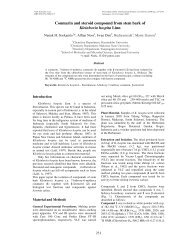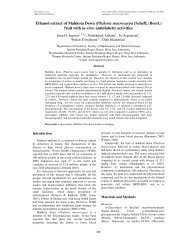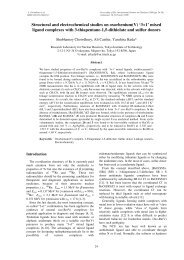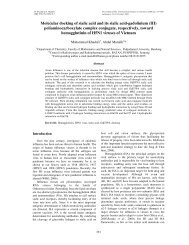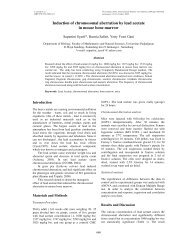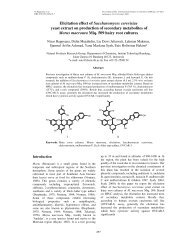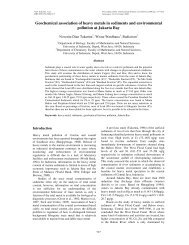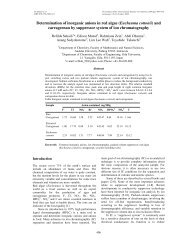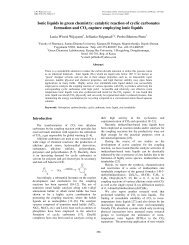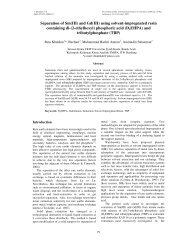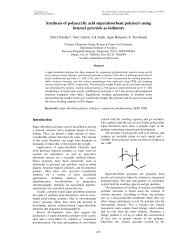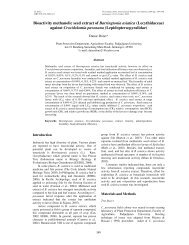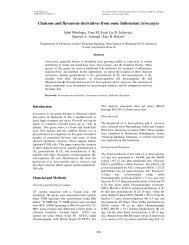Acute toxicity study and LD50 determination of MTC fraction from ...
Acute toxicity study and LD50 determination of MTC fraction from ...
Acute toxicity study and LD50 determination of MTC fraction from ...
You also want an ePaper? Increase the reach of your titles
YUMPU automatically turns print PDFs into web optimized ePapers that Google loves.
S.D.S. B<strong>and</strong>jarnahor et al. Proceeding <strong>of</strong> The International Seminar on Chemistry 2008 (pp. 676-678)<br />
ISBN 978-979-18962-0-7<br />
Jatinangor, 30-31 October 2008<br />
<strong>Acute</strong> <strong>toxicity</strong> <strong>study</strong> <strong>and</strong> <strong>LD50</strong> <strong>determination</strong> <strong>of</strong> <strong>MTC</strong> <strong>fraction</strong> <strong>from</strong><br />
Aspergillus terreus Koji<br />
S.D.S Banjarnahor*, Risna T. Dewi, Indah D. Dewijanti, M.Angelina<br />
Research Centre for Chemistry Indonesian Institute <strong>of</strong> Science, Kawasan PUSPIPTEK Serpong<br />
Tangerang, 15314, Indonesia<br />
*e-mail:s<strong>of</strong>na99@yahoo.com<br />
Abstract<br />
The acute oral <strong>toxicity</strong> <strong>of</strong> Aspergillus terreus koji extracted by <strong>MTC</strong> <strong>and</strong> oral median lethal dose<br />
(<strong>LD50</strong>) <strong>determination</strong> by Reed-Muench Method was evaluated in mice. Varying doses <strong>of</strong> the extract<br />
were administred orally for 14 days <strong>of</strong> treatment (2 g/kgbw, 4 g/kgbw, 8 g/kgbw <strong>and</strong> 16 g/kgbw) <strong>and</strong><br />
produced six mortality in male mice <strong>and</strong> seven mortality in female mice, no acute signs <strong>of</strong> <strong>toxicity</strong><br />
<strong>and</strong> abnormalities in gross findings were observed throughout the 14 days period <strong>of</strong> treatment. The<br />
daily body <strong>and</strong> organ weight showed no significant differences between the control <strong>and</strong> the mice<br />
treated with the extract. Oral <strong>LD50</strong> by Reed-Muench Method in male mice had the same values as in<br />
female mice which is 16 g/kg body weight. These findings suggest that the <strong>MTC</strong> <strong>fraction</strong> <strong>of</strong> Koji<br />
Aspergillus terreus could be relatively safe when administered orally in mice.<br />
Keywords: <strong>Acute</strong> oral <strong>toxicity</strong>, A.terreus koji, <strong>LD50</strong>, <strong>MTC</strong> <strong>fraction</strong>, Reed-Muench Method<br />
Introduction<br />
Aspergillus terreus is a cosmopolitan fungus which is<br />
primarily isolated <strong>from</strong> compost, plant material, <strong>and</strong><br />
<strong>from</strong> soil. It is more common in tropical or sub –<br />
tropical areas. Aspergillus terreus is an especially<br />
prolific producer <strong>of</strong> secondary metabolites has<br />
biological activities, such as: terrecyclodiol as<br />
antibiotic <strong>and</strong> antifungal (Almassi et al., 1996),<br />
lovastain as anti cholesterol (Schimel et al., 1998),<br />
asterriquinone as anti neoplastich (Kaji et al., 1994)<br />
<strong>and</strong> aspulvinone <strong>and</strong> kodaistatin as inhibitor <strong>of</strong><br />
hepatic glucose-6 phosphatase system (Vertesy et al.,<br />
2000). Our previous <strong>study</strong> on <strong>MTC</strong> <strong>fraction</strong> <strong>of</strong> ethyl<br />
acetate extract <strong>of</strong> Koji A.terreus Koji shows<br />
significant activity as inhibitory <strong>of</strong> α-glucosidase<br />
(IC50
S.D.S. B<strong>and</strong>jarnahor et al. Proceeding <strong>of</strong> The International Seminar on Chemistry 2008 (pp. 676-678)<br />
Jatinangor, 30-31 October 2008<br />
<strong>Acute</strong> Toxicity Study<br />
Briefly, mice were divided into five groups <strong>of</strong> six<br />
male <strong>and</strong> female. The treated group was orally given<br />
the Koji <strong>MTC</strong> <strong>fraction</strong> in a single dose with varied<br />
doses (2 g/kgbw, 4 g/kgbw, 8 g/kgbw <strong>and</strong> 16<br />
g/kgbw), while the control group received only water<br />
vehicle. The animals were monitored for apparent<br />
signs <strong>of</strong> <strong>toxicity</strong> for 14 days. The animals that died<br />
within this period were subjected to necropsies. All<br />
mice were weighted <strong>and</strong> sacrificed on the 15 th day<br />
after administration, <strong>and</strong> then the vital organs<br />
including heart, livers, lungs, kidneys, spleen, adrenal,<br />
gaster, <strong>and</strong> sex organs were grossly examined.<br />
<strong>LD50</strong> Determination<br />
Sixty mice were r<strong>and</strong>omly divided into five groups (6<br />
in each group) male <strong>and</strong> female. The experimental<br />
group received the <strong>MTC</strong> <strong>fraction</strong> <strong>of</strong> A.terreus koji<br />
through a gastric tube at several dose levels (2<br />
g/kgbw, 4 g/kgbw, 8 g/kgbw <strong>and</strong> 16 g/kgbw) while<br />
the control group received only water vehicle. The<br />
animals were observed continuously during the 14<br />
days <strong>of</strong> treatment. The analysis <strong>of</strong> <strong>LD50</strong> was<br />
evaluated using the Reed <strong>and</strong> Muench Method (Reed<br />
<strong>and</strong> Muench, 1958).<br />
Statistical Analysis<br />
Results were expressed as mean ±st<strong>and</strong>ard error <strong>of</strong><br />
mean (S.E.M.). Statistical significance was<br />
determined by one-way analysis <strong>of</strong> variance<br />
(ANOVA) <strong>and</strong> least significance difference (LSD)<br />
test. P values less than 0.05 were considered<br />
significant.<br />
Results <strong>and</strong> Discussion<br />
Oral administration <strong>of</strong> <strong>MTC</strong> <strong>fraction</strong> <strong>from</strong> A.terreus<br />
koji in doses <strong>from</strong> 2 g./kgbw to 16 g/kgbw did not<br />
produce significant changes in behavior, breathing,<br />
cutaneus effects, sensory nervous system responses<br />
<strong>and</strong> gastrointestinal effects in male <strong>and</strong> female mice<br />
(data not shown) these effect are observed during the<br />
experimental period (2 h after oral route). During the<br />
14 days <strong>of</strong> treatment there were thirteen mortalities in<br />
both male <strong>and</strong> female groups <strong>and</strong> at the highest dose<br />
(16 g/kgbw) there was fifty percent <strong>of</strong> mortality. The<br />
alteration <strong>of</strong> body weight gain <strong>and</strong> organ weights<br />
<strong>from</strong> the control would reflect the <strong>toxicity</strong> <strong>of</strong> the<br />
substance (Carol, 1995) significant difference in<br />
organ weights between treated <strong>and</strong> untreated (control)<br />
animals may occur in the absence <strong>of</strong> any<br />
morphological changes (Bailey et al., 2004). Internal<br />
organ weights both in male <strong>and</strong> female mice were<br />
recorded as shown in table 1, while body weight in<br />
mice were illustrated in figure 1 for female group <strong>and</strong><br />
figure 2 for male group, respectively. Neither body<br />
weight nor internal organs weight <strong>of</strong> treated mice was<br />
significantly changed relative to that <strong>of</strong> the control<br />
group. Gross examination <strong>of</strong> the internal organs<br />
revealed no pathological abnormality relative to the<br />
control (data not shown).<br />
The median lethal dose (<strong>LD50</strong>) obtained <strong>from</strong> the<br />
Reed Muench Method (Reed <strong>and</strong> Muench, 1958) is 16<br />
g/kgbw for male <strong>and</strong> female mice. The result showed<br />
that <strong>MTC</strong> <strong>fraction</strong> <strong>from</strong> A.terreus koji is practically<br />
non toxic for oral administration.<br />
Table 1 Organ weight <strong>of</strong> mice in the acute <strong>toxicity</strong> <strong>study</strong> <strong>of</strong> the <strong>MTC</strong> <strong>fraction</strong> <strong>from</strong> Koji Aspergillus terreus<br />
Control<br />
Koji <strong>MTC</strong><br />
2 g/kgbw 4 g/kgbw 8 g/kgbw 16 g/kgbw<br />
Female<br />
Lung 291.62±20.33 248.5±28.30 243.05±8.77 220.08±20.75 331.67±50.71<br />
Heart 143.53±5.22 138.8±19.10 148.67±7.74 137.74±4.94 129.37±22.81<br />
Liver 1840±54.31 1710.9±232.42 1734.58±102.15 1644.08±115.83 1640.10±290.67<br />
Spleen 103.42±4.47 148±32.7 92.32±14.82 84.46±7.86 127.30±19.15<br />
Adrenal 285.93±42.99 251.8±55.15 284.15±38.46 266.86±33.95 330.50±58.30<br />
Kidney 463.95±20.81 414±56.5 440.33±23.22 397.7±17.32 441.83±71.87<br />
Ovary 46.22±11.20 61.3±11.96 39.65±8.08 19.14±3.00 43.87±14.79<br />
Male<br />
Lung 231.65±15.99 236.4±11.06 249.87±8.89 238.34±16.61 248.48±18.66<br />
Heart 169.2±12.12 164.6±5.32 201.67±32.38 127.58±8.10 130.4±8.05<br />
Liver 1822±51.41 1899.3±71.55 1949.48±94.24 1652.3±105.69 1709.02±77.23<br />
Spleen 82.55±6.84 84.1±5.45 94.20±11.08 70.08±7.65 87.4±14.81<br />
Adrenal 419.65±7.69 256.2±22.25 726.48±36.71 408.18±47.41 315±52.84<br />
Kidney 479.35±24.78 464.6±77.04 505.62±28.21 468.94±49.76 496.46±19.33<br />
Testis 257.95±2.09 271.4±10.98 279.47±9.78 266.5±11.19 207.94±42.89<br />
677
S.D.S. B<strong>and</strong>jarnahor et al. Proceeding <strong>of</strong> The International Seminar on Chemistry 2008 (pp. 676-678)<br />
Jatinangor, 30-31 October 2008<br />
References<br />
Figure 1 Body weights <strong>of</strong> female mice in the acute<br />
<strong>toxicity</strong> <strong>study</strong> <strong>of</strong> <strong>MTC</strong> <strong>fraction</strong> <strong>from</strong> A.terreus koji<br />
Figure 2 Body weights <strong>of</strong> male mice in the acute<br />
<strong>toxicity</strong> <strong>study</strong> <strong>of</strong> <strong>MTC</strong> <strong>fraction</strong> <strong>from</strong><br />
A.tereus koji<br />
Conclusions<br />
A single oral dose <strong>of</strong> 2 g/kgbw, 4 g/kgbw, 8 g/kgbw<br />
<strong>and</strong> 16 g/kgbw <strong>of</strong> <strong>MTC</strong> <strong>fraction</strong> <strong>from</strong> A.terreus koji<br />
are unable to induce toxic effects although there were<br />
thirteen deaths occurred during the experimental<br />
period. <strong>LD50</strong> <strong>from</strong> Reed Muench Method is 16<br />
g/kgbw for male <strong>and</strong> female mice. In summary, the<br />
data on the acute <strong>toxicity</strong> <strong>study</strong> indicates that <strong>MTC</strong><br />
<strong>fraction</strong> <strong>from</strong> A.terreus koji is practically non toxic<br />
for oral administration.<br />
Acknowledgements<br />
The authors thank the DIPA LIPI in Drug<br />
Competitive Programme “The Development <strong>of</strong> Basic<br />
Commodity Drugs Based on Indonesian Biodiversity”<br />
for the trust to conduct the research in our laboratory.<br />
Almassi,F.,L.Emilio,S.Brian<strong>and</strong>H.W.Allan,1996.<br />
Molecular structure <strong>of</strong> terrecyclicclodiol : A<br />
Derivative <strong>of</strong> the antifungal metabolite terrecyclic<br />
acid <strong>from</strong> Aspergillus terreus. J.Nat.Prod., 59 : 59-<br />
61.<br />
Kaji, A., T.Iwata, N.Kiriyama, S.Wakusawa <strong>and</strong><br />
K.Miyomoto, 1994. Four new metabolites <strong>of</strong><br />
Aspergillus terreus. Chem.Pharm.Bull. (Tokyo),<br />
42:1682–1684.<br />
Vertesy,L.,H.Burger,J.Kenja,M.Knauf,H.Kogler,E.F.<br />
Paulus,N.V.Ramakrishn,K.H.Swamy,E.F.Vijayku<br />
mar<strong>and</strong> Hammann, 2000.Kodaistatin, novel<br />
inhibitor<strong>of</strong>glucose-6-phospate translocase TI, <strong>from</strong><br />
Aspergillus terreus thom DSM 11247. Isolated<br />
<strong>and</strong> structural elucidation. MEDLINE, 53 : 677-<br />
686.<br />
Triana, D.R., M.Yeti, M.Hanafi <strong>and</strong> L.B.S.Kardono.<br />
2006. Inhibitory effect <strong>from</strong> ethyl acetate extract<br />
<strong>of</strong> Aspergillus terreus on α-glucosidase activity.<br />
Proceeding <strong>of</strong> National Chemistry Seminar <strong>and</strong><br />
National Congress <strong>of</strong> HKI, pp : 648-655 (In<br />
Indonesian language).<br />
P.SubashBabu,S.Prabuseenivasan,S.Ignacimutu,<br />
2007.Cinnamaldehyde- A potential antidiabetic<br />
agent. Phytomedicine, 14 : 15-22.<br />
Chait, A., Brunzell, J.D., 1996. Diabetes, Lipids, <strong>and</strong><br />
atherosclerosis. In : LeRoith, D.,Taylor, S.I.,<br />
Olefsky, J.M. (Eds), Diabetes Mellitus.<br />
Lippincott-Raven Publisher, Philadelphia, pp.<br />
467-469.<br />
B.Ramesh <strong>and</strong> K.V.Pugalendi, 2005.<br />
Antihyperlipidemic <strong>and</strong> antidiabetic effects <strong>of</strong><br />
Umbelliferone in Streptozotocin in Diabetic Rats.<br />
Yale Journal <strong>of</strong> Biology <strong>and</strong> Medicine.,78: 187-<br />
194.<br />
Kmietowicz. Z, 2002. WHO warns <strong>of</strong> heart disease<br />
threat to developing world. BMJ, 325 : 853.<br />
Navab, M, Fogelman A.M, Berliner J.A.,et al, 1995.<br />
Pathogenesis <strong>of</strong> atherosclerosis, Amer J Cardiol,<br />
76 : 18c-23c.<br />
Reed LJ <strong>and</strong> Muench M. 1958. A simple method <strong>of</strong><br />
estimating fifty percent end product, Am J 1 Iyg<br />
27: 495-497.<br />
Carol, S.A., 1995. <strong>Acute</strong>, subchronic <strong>and</strong> chronic<br />
toxicology. In : Michael, J.D., Manfred, A.H.,eds.<br />
CRC H<strong>and</strong>book <strong>of</strong> toxicology. U.S.A. : CRC<br />
Press, Inc., 51-104.<br />
Bailey, S.A., Zidell, R.H. <strong>and</strong> Perry, R.W. 2004.<br />
Relationships between organ weight <strong>and</strong><br />
body/brain weight in the rat : what is the best<br />
analytical endpoint. Toxicol.Pathol., 32(4) : 448-<br />
466.<br />
678



